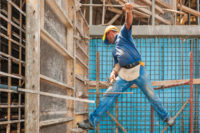Are your workers blind to safety?

It is an unfortunate but predictable outcome that Jonathan will not hear the backup alarm of the forklift coming from the left down the main aisle or see it coming. It is also predictable that the forklift driver’s attention will be focused on his path, his destination, and the unstable load he is carrying. This is due to a phenomenon called inattention blindness. The basic premise of inattention blindness is that when an employee (or anyone) is focusing their attention on one thing, they are less likely to notice something else that appears, even if it is right in front of them. For a fantastic example, check out the Selective Attention Test video on YouTube1. It is funny and scary at the same time because of how well it works.
A false sense of security
The major cause of inattention blindness is not how much sensory information the employee is trying to process; it is due to the cognitive workload. The deeper an employee is concentrating on something, the less likely he or she is to notice incoming hazards. The one factor that seems to make a difference is a sensory gradient. If the incoming hazard looks very different from everything else in the visual field, it stands out more and has a better chance of being noticed. But most safety hazards are more likely to resemble the background and won’t pop out enough to be noticed.
Ironically, the more experienced the worker is, the more likely he or she is to fall victim to inattention blindness. This is because the more we go through a process without incident, the more our brain tells us that we don’t need to look around for hazards. We get a false sense of security. On the other hand, novices look around because they don’t know any better.
But of course we don’t want people to stay novices forever. So what can we do? We can leverage many of the tools in our safety toolbox, including design, administration and training to fight inattention blindness. In this article, I am going to focus on training; in particular, naturalistic training.
Keep it real
A good example of how this can work was demonstrated using older drivers. The stereotypical explanation for why older drivers get into more crashes when they reach an intersection is that their cognitive and perceptual abilities start to degrade, and they don’t see cars coming from either side.
But it turns out that inattention blindness is a larger component. As I described earlier, experts are more susceptible to inattention blindness because they have learned what to focus on — and more importantly what not to focus on — when they are in a high workload situation. What happens with older drivers is that they focus intently on the area that experience has taught them is the most dangerous, the most likely to contain a hazard. For older drivers, the most common incident is rear-ending the car in front. So they look intently forward. In theory, this is a good thing. But because of inattention blindness, their focused attention causes them to miss vehicles or pedestrians suddenly appearing in other locations. Not because their perceptual abilities aren’t up to the job, but because they have a laser-like focus on the car in front.
Naturalistic training makes a huge difference. The training has several components. First, older drivers are filmed as they drive near their homes. These drivers are shown the videos and where their visual scanning is deficient. Then they use a driving simulator to practice an improved scan path that is more effective at balancing the risks of rear-end collisions and cars intruding from the side. Results are significant. After training, older drivers’ performance is indistinguishable from younger, experienced drivers, and this effect lasted at least through a one-year follow-up.
Another study examined how similar the training tasks have to be to the work tasks to combat inattention blindness. This is important because creating a realistic simulation may be challenging and expensive, but using the actual workplace for training may not be feasible. A low fidelity simulation would be cheap and easy, but would it work? It turned out to be a sliding scale. The more similar the tasks are, the more resistance to inattention blindness is developed.
An honest appraisal
So what does this all teach us? First, we need to do an honest appraisal of our workplace incidents to see where inattention blindness is a significant factor. The reality is that it appears much more than you might suspect. And where it does, consider a naturalistic training intervention that is sufficiently realistic to overcome the inattention blindness but is feasible in terms of cost and effort.
Footnote
Looking for a reprint of this article?
From high-res PDFs to custom plaques, order your copy today!





